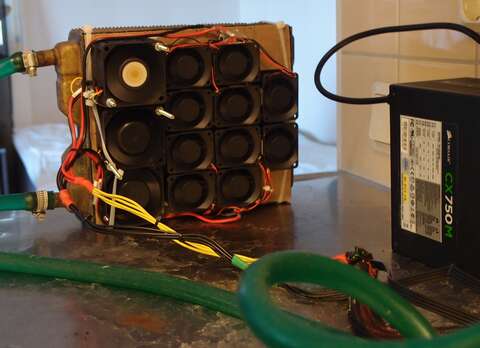Due to the increasingly hot summers here in Sweden, I wanted something I could use to keep my apartment cool during the worst days. Air conditioning units can be had for 250-500€. This is a bit on the high side for how many days per year they'd actually be used, and there is the problem of getting rid of waste heat.
Three or four years ago me and a friend built a rig for another friend of ours to keep his apartment cool, out of a PC water cooling radiator+fan and some plumbing parts. Cold water from the tap enters the radiator, and waste water is simply flushed down the drain. This worked out quite well, so I decided to replicate this idea using parts I had on hand or that I could find in the local hackerspace. The result was the picture below:
The radiator is from a car and measures 22x20x5 cm. The fans are a bunch of old server fans, mostly Delta brand. This means the cooler is very noisy - around 63 dBA. Total air flow is 7.7 m³/minute for 60 W total fan power, not accounting for the pressure drop through the radiator.
The fans are mounted to a thin MDF board, and the board itself has a "border" made of 5-6 layers of double-sided tape acting as a seal. The board is secured to the radiator using zip ties. An old PSU supplies the 12 V.
Using a digital thermometer and a timer I was able to determine the temperature difference and flow rates for two different settings on the faucet. From this I was able to determine the cooling power. The results are listed in the table below:
| Flow rate (ml/s (l/h)) | Temperature diff (°C) | Cooling power (W (BTU/h)) | Efficiency (J/ml) |
|---|---|---|---|
| 6.49 (23.4) | 7.7 | 209 (713) | 32.2 |
| 24.4 (87.8) | 5.5 | 561 (1914) | 23.0 |
Higher flow rates means more cooling, but also more wasteful use of water. The inlet water was cooler during the higher flow test, 12.8°C vs 16.6°C, which has likely skewed the results. Room temperature remained around 24-26°C.
All in all this works well enough to cool the area around my bed. The noise keeps it from being useful at night or when I'm reading, unless I replace the PSU with an adjustable supply. A better passive solution would be to install awnings on the south wall of the building to keep the sun from warming up the inside, but unfortunately I'm not allowed to do that since it's owned by the municipality.
